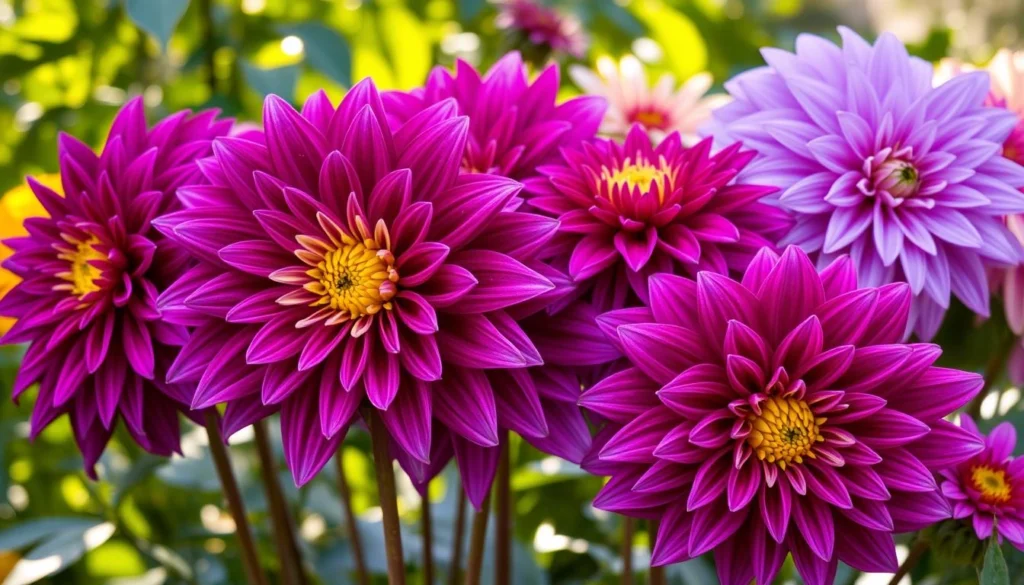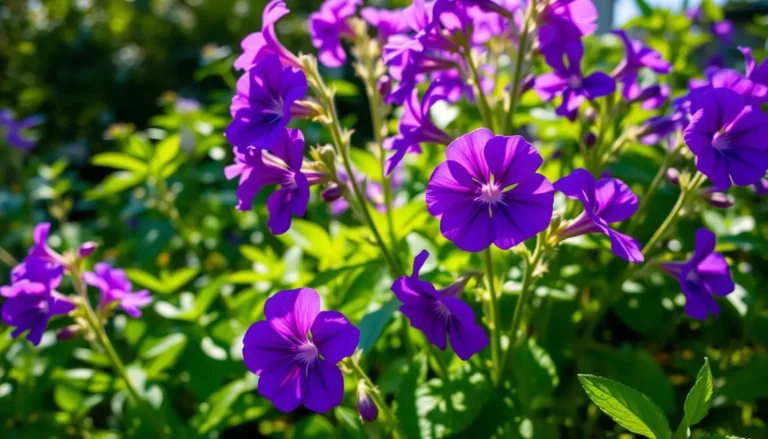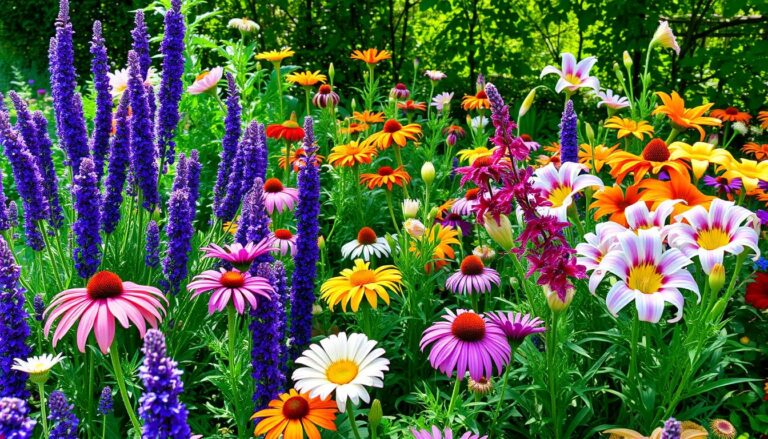Dahlia Flowers: 7 Secrets to Unlock Rare Varieties & Care
Dahlias are known for their stunning, vibrant blooms that brighten gardens from mid-summer to fall. These tender perennials come in many shapes, sizes, and colors. They are a favorite among flower enthusiasts. This article will share 7 secrets for growing and caring for dahlia flowers. You’ll learn how to select rare varieties and master expert-level techniques for optimal growth and bloom production.
Dahlia seeds sprout in 14-21 days after sowing, depending on the variety and growing conditions1. Dahlias need soil temperatures between 70-80°F (21-27°C) for the best germination1. They should get at least 6 hours of direct sunlight a day for successful growth1. With the right care and attention, you can unlock a stunning array of rare and unique dahlia blooms. These will transform your garden into a vibrant oasis.
Key Takeaways
- Dahlias come in a vast array of shapes, sizes, and colors, making them a favorite among flower enthusiasts
- Optimal growing conditions include soil temperatures between 70-80°F (21-27°C) and at least 6 hours of direct sunlight per day
- Proper care and attention can help you unlock a stunning array of rare and unique dahlia blooms
- Selecting the right dahlia varieties and following expert-level techniques are key to achieving a vibrant dahlia garden
- Understanding the secrets of dahlia cultivation can help you create a captivating and long-lasting floral display
The Allure of Growing Dahlias from Seed
Growing dahlias from seed is an exciting adventure. It’s different from planting tubers2. You can choose from many dahlia seed varieties, like pom-poms or dinner-plate blooms. This lets you create a unique garden display2.
Exploring these varieties opens up a world of colors, textures, and shapes. They will make your garden and visitors happy.
Selecting Seeds: Begin with Quality
Choosing high-quality seeds is key when growing dahlias from seed2. These seeds help your dahlias grow strong and bloom brightly. Quality seeds mean a better growing experience for you.
Exploring Dahlia Seed Varieties
Dahlia seed varieties are incredibly diverse2. You can find simple single blooms or complex double flowers like cactus dahlias. This variety lets you create a stunning garden display2.
Sourcing High-Quality Dahlia Seeds
Finding quality dahlia seeds is important for great results2. Look for sellers who offer rare and unique dahlias. They have a wider selection and better quality seeds2. Good seeds mean a great dahlia garden.
Considering Rare and Unique Varieties
Adding rare dahlias to your garden makes it more interesting and helps preserve biodiversity2. Varieties like Café au Lait dahlias are hard to find but worth it3. Growing these dahlias makes your garden truly special.
“The 19th century saw a boom in dahlia cultivation, with breeders in England, the Netherlands, and other European countries developing countless new varieties.”2
Germination: The Foundation for Growth
Dahlia seed germination is key to growing rare and unique varieties. By following a few steps, you can ensure successful seedling emergence. This marks the beginning of your dahlia-growing journey.
Preparing the Seed-Starting Medium
Start by choosing a lightweight, nutrient-rich seed-starting mix4. It should help your dahlia seeds sprout and grow strong roots. Heavy potting soils can slow down germination and early growth.
Sowing and Maintaining Proper Moisture
Sow your dahlia seeds about 1/4 to 1/2 inch deep4. It’s important to keep the soil moist but not too wet. Aim for a moisture level like a wrung-out sponge. Use a gentle misting or watering to avoid harming the seeds.
Providing Optimal Light and Temperature
Dahlia seeds need warm, bright conditions. Give them indirect, but plenty of light, and keep the temperature between 70-80°F (21-27°C)5. This warmth and light will help them germinate quickly and evenly, usually in 14-21 days.
Monitoring for Seedling Emergence
Watch your seed trays or containers daily for seedling emergence5. When you see the first sprouts, get ready to care for them. This will help them grow strong and vibrant.
By carefully preparing the medium, sowing seeds, maintaining moisture and temperature, and watching for seedlings, you’re on your way. You’ll grow a stunning array of dahlia flowers from seed45.
Transplanting: Nurturing Your Starters
When your dahlia seedlings grow their true leaves, it’s time to move them to individual pots. This step is key for strong roots and better growth6. Pick the right pot size and use a mix that drains well. When moving them, lift by the leaves to protect the roots7.
Preparing Individual Pots
Opt for pots that are a bit bigger than the seedling’s roots, about 4-6 inches. Use a good potting mix that drains well and has organic matter. This mix will feed and hold moisture for your seedlings6.
Transplanting Technique
When moving the seedlings, lift them by the leaves carefully. Plant them in the pots, making sure the soil level is the same as before. Press the soil around the seedlings to keep them in place7.
Acclimating to Increased Light
After moving, slowly get the seedlings used to more light. Start in a shaded spot for a few hours, then more sunlight over time. This helps them adjust to their new home6.
Maintaining Optimal Growing Conditions
Give your seedlings at least 6 hours of direct sunlight a day8. Keep the soil moist but not soggy. This prevents diseases. Use a balanced fertilizer after a month to help them grow strong and bloom well67.
By following these steps, you can care for your dahlia seedlings well. This will help your garden grow full and beautiful678.
Soil Preparation: The Underground Magic
Getting dahlias to grow well starts with good soil. Dahlias love rich, well-draining soil with a pH between 6.0 and 7.09. It’s key to check and fix the soil to help dahlias grow their best.
Assessing and Amending Soil
First, test your soil to know its type and pH. Add compost or aged manure if needed to make the soil better10. This is very important, as a farm in Burt, NY, saw great dahlia growth in 2022 with clay soil, unlike the sandy soil before10.
Achieving the Ideal Soil Texture
The best soil for dahlias is like a sponge, holding water but not too much9. Adding the right organic matter helps dahlias grow strong roots and absorb nutrients well10.
The Benefits of Mulching
Putting a 2-3 inch layer of organic mulch around dahlias helps a lot. Mulch keeps the soil moist, stops weeds, and keeps the soil cool, all good for dahlias9.

Soil preparation is key for growing beautiful dahlia flowers. By checking, fixing, and mulching the soil, you make a great place for dahlias to grow and bloom brightly.
Nutrient Supplementation and Fertilization
Dahlias love to eat and need regular food to grow well and bloom11. Start by adding a slow-release fertilizer to the soil before planting11. Then, use a water-soluble fertilizer every two to three weeks during the growing season11. This keeps your dahlias looking their best.
When fertilizing dahlias, it’s all about balance11. Choose a fertilizer with a 10:10:10 NPK ratio for the right mix of nutrients11. Later, use a potassium-rich fertilizer as a root drench twice a week when they start flowering11. This boosts their blooms and growth.
Dahlias in pots need extra care because the soil can lose nutrients11. Make sure the potting mix is rich in organic matter for healthy growth11. Also, remember to feed them every six weeks to keep them nourished11.
Managing nutrients is key for dahlias12. With the right fertilization, your dahlia garden will flourish and look amazing11. Try different fertilizers and ways to apply them to find what works best for your dahlias13.
Planting Outdoors: Timing is Everything
As spring warms up and the last frost goes away, it’s time to plan for planting dahlias outside. Dahlias are sensitive to cold, so timing is key14. The author starts getting dahlias ready for the garden in late April. They give the tubers 4 weeks to sprout before planting in early June14.
Planting in early June is best because dahlias don’t like cold, wet soil14. The author lives in Zone 3a and says the risk of frost is low by early June.
Hardening Off Your Dahlia Seedlings
Before moving dahlias outside, they need to get used to the outdoors slowly. This is called “hardening off.”15 It helps them adjust to more light, wind, and temperature changes15. Seedlings are usually moved outside 3 to 4 weeks after the last frost. Seeds should start indoors 4 to 8 weeks before going outside15.
The hardening off process takes 7 to 14 days. During this time, seedlings get used to being outside more.
Selecting an Optimal Planting Location
When dahlias are ready for the outdoors, pick the best spot. Dahlias need at least 6 hours of sunlight a day15. Plant them 12 in (30 cm) apart in the garden. Seedlings can be as close as 4 in (10 cm) apart15.
Choosing the right spot helps dahlias grow strong roots and bloom well.

“Timing is everything when it comes to planting dahlias outdoors. By waiting for the right moment and properly acclimating your seedlings, you’ll set the stage for a thriving and beautiful dahlia garden.”
dahlia flowers: Expert Insights
Drew English, the head gardener at High Hampton in Cashiers, North Carolina, shares expert tips for growing dahlias and dahlia gardening expertise. They teach how to pick the best tubers and how to prune them correctly. Their advice helps gardeners grow beautiful dahlias in their gardens16.
Dahlias are now more popular than ever in the flower world16. Introduced to Europe in the 1700s from Central America, they come in many colors and sizes16. To grow them well, it’s important to avoid overwatering and underwatering16.
When planting dahlia tubers, place them horizontally with at least one eye facing up16. Taller varieties might need support to stay upright16. The soil should be rich and warm enough for growth16. Fertilize them with bone meal at planting and balanced fertilizer every 3-4 weeks16.
Dahlias are easy to grow and bloom for most of spring and summer17. They love full sun and need 6 to 8 hours of sunlight daily17. Young plants will start flowering after 4 months, and older ones need regular watering17. Pruning them helps get bigger flowers17.
Bahlias last 5-7 days in a vase, while dahlias last 4-6 days18. Bahlias have a sweet scent, perfect for indoor arrangements, but dahlias don’t have a strong fragrance18. Bahlias are soft and colorful, while dahlias are bold and dramatic18.
By following expert dahlia cultivation advice, gardeners can grow stunning dahlias in their gardens.
Caring for Dahlia Plants
Proper care is essential for dahlia plants to grow and bloom well. They need consistent watering and thoughtful fertilization. Knowing their specific needs helps them reach their full beauty19.
Watering Dahlias
Dahlias need moist, well-draining soil. Water them in the early morning to avoid fungal problems19. They should get watered once or twice a week, based on the weather19.
Fertilizing Dahlia Flowers
Use a balanced, water-soluble fertilizer regularly during the growing season. This gives dahlias the nutrients they need for lush growth and bright flowers19. A fertilizer with more phosphorus, like a 10-30-20 ratio, helps them bloom more19.
| Dahlia Care Requirement | Optimal Condition |
|---|---|
| Sun Exposure | Full sun, 6-8 hours per day19 |
| Soil Type | Rich, loamy soil with good drainage19 |
| Blooming Period | June to September, through the fall19 |
| Tuber Planting Depth | 2 to 6 inches19 |
| Fertilizer Ratio | High phosphorus, e.g., 10-30-2019 |
Understanding how to water and fertilize dahlia plants is key. This knowledge helps gardeners grow these stunning flowers. Enjoy their vibrant blooms all season long1920.
Conclusion
By following this guide, gardeners can unlock dahlias’ full potential21. They learn how to pick the best seeds or tubers and transplant them. They also learn about soil preparation and ongoing care. These 7 secrets help grow a stunning dahlia display in any garden21.
With the right knowledge and dedication, dahlia lovers can enjoy these blooms from mid-summer to the first frost22.
Dahlias are versatile and carry deep meanings for various celebrations22. They can mark special life events, express feelings, or add elegance to your space23. Their colors, like deep red and purple, represent passion. White and pink symbolize commitment and bonding23.
As you grow and show off these blooms, remember to give them love and care21. By using the secrets from this guide, you’ll unlock dahlias’ true beauty. You’ll create a display that will amaze and inspire everyone22.
Let dahlias show off your gardening skills and the beauty of nature23.







